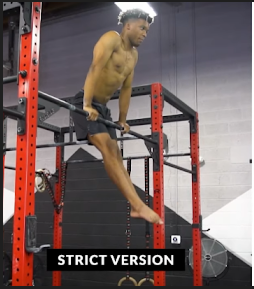🤯Which muscle-up reigns supreme in your training routine—the explosive kipping muscle-up or the controlled strict muscle-up?
As a coach who’s seen the impact of both techniques, I know this debate stirs up strong opinions in the fitness community. Each style has its own unique benefits and challenges; depending on your goals, one might just edge out the other.
So, whether you’re striving for raw strength, efficiency, or a combination of both, let’s break down the pros and cons of kipping and strict muscle-ups to determine which one should be your go-to move.
🤔What are Muscle-Ups?
Before we jump into kipping and strict bar muscle-ups, let’s first discuss what muscle-ups are. Muscle-ups are a powerful bodyweight exercise that combines the pull-up and the dip into one fluid movement.
Performed on a bar or rings, muscle-ups require you to pull yourself up over the bar until your chest is above it, then press your body up until your arms are fully extended. This move showcases strength and skill, making it a sought-after milestone in calisthenics and fitness training.
Here’s how a muscle-up works:💯
- Pull-Up Phase: You start by pulling yourself up as in a standard pull-up. Pulling your chest as close to the bar as possible is the goal.
- Transition Phase: Once your chest is at bar level, you shift your body forward over the bar. This is the most technical part of the movement, requiring strength and skill to move your torso above the bar.
- Dip Phase: After the transition, you perform a dip by pressing down on the bar, and extending your arms to lift your upper body entirely above the bar.
💪 Muscle-ups come in two main variations:
- Strict Muscle-Up: Performed with minimal momentum, relying on pure strength, particularly in the lats, shoulders, and triceps.
- Kipping Muscle-Up: Utilizes a swinging motion, or “kip” to generate momentum, making the exercise easier and more dynamic.
Muscle-ups are a significant achievement in calisthenics and bodyweight training, symbolizing a high fitness level and upper-body strength.
🙌 The Kipping Bar Muscle-Up: Speed and Momentum
The kipping bar muscle-up is an explosive variation of the muscle-up that uses speed and momentum to get you over the bar. Unlike the strict muscle-up, which focuses on strength and control, the kipping version relies on a swinging motion to make the transition smoother and faster. This technique is popular in CrossFit and functional fitness for its efficiency in high-intensity workouts.
✊ How to Perform a Kipping Bar Muscle-Up:
- Start with a Swing: Begin by swinging your legs forward, then drive them backward to create momentum.
- Pull with Force: As your legs swing back, pull with your arms to lift your hips toward the bar.
- Transition Quickly: Rotate your wrists over the bar as your hips rise, making the transition smooth.
- Press Up: Finish by pressing your body until your arms extend above the bar.
🎯 Pros:
- Easier to Learn: If you’re new to muscle-ups, the kipping variation is often the more accessible starting point. Using momentum reduces the strength required to get over the bar. This makes it achievable for a broader range of athletes, especially those still building their upper-body strength.
- Faster Repetitions: For those of you competing or just trying to crank out more reps, Kipping allows for quicker cycles. The momentum helps you conserve energy, meaning you can bust out more reps in less time—perfect for competition settings.
- Less Fatigue: Thanks to the momentum, your muscles don’t tire as quickly, allowing for more endurance. This is great for workouts where volume is vital, as you can keep going longer without burning out too soon.
⚡️ Cons:
- Less Upper-Body Strength Development: The downside of relying on momentum is that your muscles don’t have to work as hard. This means that, over time, you might not develop as much upper-body strength compared to doing strict muscle-ups.
- Higher Risk of Injury: Kipping can be a double-edged sword. The dynamic movement and reliance on momentum can lead to poor form, especially when tired. This increases the risk of injury, particularly to your shoulders and wrists.
- Hand Wear and Tear: Those kip swings are no joke on your hands. The friction between your hands and the bar is much higher in kipping muscle-ups, which can lead to some gnarly blisters and calluses.
Related articles:
- Mastering the Kipping Muscle Up on the Bar: A Comprehensive Progression Guide
- Mastering the Kipping Muscle Up on the Bar: A Comprehensive Progression Guide (Part 2)
- Master the Art of Kipping Muscle Ups: Your Ultimate Guide to Perfect Technique!
🙌 The Strict Bar Muscle-Up: Strength and Control
The strict bar muscle-up is a pure display of strength and control, requiring you to rely solely on your upper-body power to pull yourself over the bar without any momentum or swinging. This variation demands a high level of strength, especially in your back, shoulders, and arms, and precise technique to smoothly transition from the pull-up to the dip.
✊ How to Perform a Strict Bar Muscle-Up:
- Start from a Dead Hang: Start by hanging from the bar with your arms extended and your body still.
- Pull Up Strongly: Engage your lats and pull yourself up, bringing your chest as close to the bar as possible.
- Transition Smoothly: As your chest reaches the bar, lean forward to transition your body over the bar.
- Press Up: Press down on the bar with your triceps to extend your arms and lift your body above the bar.
Check out this YouTube video on strict bar muscle-up mastery:
🎯 Pros:
- Greater Strength Development: No momentum here, folks—just pure muscle power. The strict bar muscle-up forces you to engage your muscles fully, making it an excellent exercise for building upper body strength.
- Better Control and Body Awareness: Performing a strict muscle-up requires you to move through each phase of the exercise slowly and deliberately. This strengthens your muscles and enhances your control and body awareness, crucial for mastering advanced calisthenics skills.
- Lower Injury Risk: With no sudden or dynamic movements, the strict bar muscle-up is much easier on your joints. The controlled nature of the exercise reduces the likelihood of injuries, making it a safer option, especially for beginners or those rehabbing from injury.
⚡️ Cons:
- Higher Strength Requirement: The biggest challenge with strict muscle-ups is requiring significantly more upper-body strength. This means it’s not as accessible for everyone, and it may take longer to achieve your first rep if you’re still building strength.
- Slower Reps, More Fatigue: Without the help of momentum, you’ll fatigue faster during strict muscle-ups. This makes it harder to do high reps, which could be a drawback if your goal is to improve endurance or perform well in competitions.
- Longer Learning Curve: Because of the higher strength requirement and need for control, it takes more time to master the strict bar muscle-uUp. Patience and persistence are key here, but the rewards are well worth it.
🧐Frequently Asked Questions
🔎 What is the difference between kipping and strict bar muscle-ups?
Kipping bar muscle-ups use the momentum generated by a swinging motion to help lift your body over the bar, making the movement faster and more efficient. Strict bar muscle-ups rely entirely on upper body strength and control without any momentum, making them more challenging and strength-focused.
🔎 Which muscle-up variation is better for building strength?
Strict bar muscle-ups are better for building raw strength, as they require full control and force from your upper body muscles without relying on momentum.
🔎 Should beginners start with kipping or strict muscle-ups?
Beginners should start with strict muscle-ups or work on developing the strength needed for strict muscle-ups through exercises like pull-ups and dips. This builds a strong foundation before attempting the kipping variation.
🔎 Can kipping muscle-ups lead to injuries?
If not done correctly, kipping muscle-ups can increase the risk of injuries, particularly to the shoulders and elbows, due to the dynamic nature of the movement. It’s essential to master the basics and maintain control throughout the exercise.
🔎 How can I improve my strict muscle-up technique?
To improve your strict muscle-up technique, focus on strengthening your pull-ups, dips, and core exercises. Practice the transition phase by working on chest-to-bar pull-ups and deep dips to build strength and control.
🔎 Can kipping muscle-ups help me perform more reps?
Yes, the momentum generated in kipping muscle-ups allows you to perform more reps in a shorter time, making them effective for increasing your overall volume in a workout.
💥Final Verdict: Which Muscle-Up Is Right for You?
At the end of the day, the choice between kipping and strict bar muscle-ups comes down to your individual goals. Kipping might be your best bet if you aim for quick reps and efficiency, especially in a competitive setting. However, if you focus on building raw strength and minimizing injury, the strict bar muscle-up is the way to go.
☝️Remember, both techniques can complement each other, so there’s no harm in mastering both. Start with the one that aligns with your current goals, and as you progress, integrate the others to round out your training.
If you’re ready to take your training to the next level, 🤜 sign up for a FREE personalized calisthenics assessment. In just 5 minutes, you’ll receive a personalized training plan tailored to your needs, with recommendations and workouts you can use immediately.




